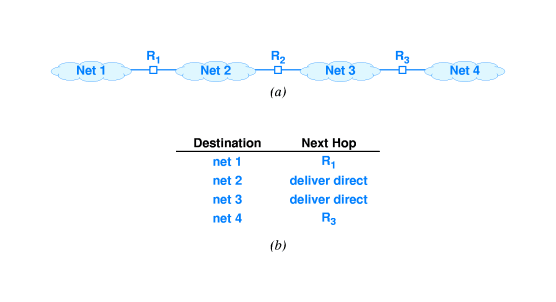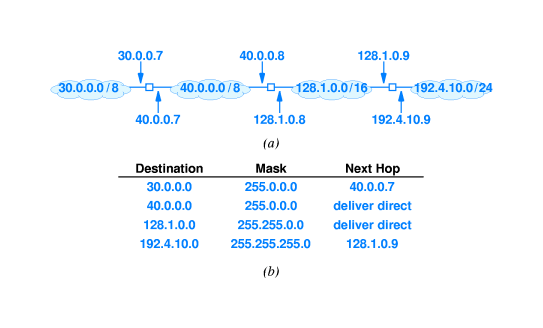(rev. 01/17/2008)
Notes On Chapter Twenty
-- IP Datagrams And Datagram Forwarding
- 20.1 Introduction
- This chapter is about:
- The format of IP packets, and
- How routers use the information in IP
packets.
- 20.2 Connectionless Service
- Fundamentally the Internet offers connectionless service, but there
is a virtual connection-based service that will be discussed more
later on.
- 20.3 Virtual Packets
- IP packets travel hop-at-a-time from router to router.
- The IP packet (aka IP datagram) has to be uniform
across the Internet, and independent of the various
physical frame formats and addressing modes of the
underlying physical networks.
- 20.4 The IP Datagram
-
 The IP datagram is pictured on page 328 of the fourth edition.
The IP datagram is pictured on page 328 of the fourth edition.
- There is a variable-sized header containing:
- Source IP address
- Destination IP address
- Other stuff
- There is a variable sized data area too -- important
flexibility for the wide range of uses of IP.
- The IPv4 standard allows an IP datagram to
contain as little as one byte of data.
- The standard allows the datagram to be as large
as 64 Kbytes total, including header.
- 20.5 Forwarding An IP Datagram
-
 Routers use routing tables.
Routers use routing tables.
- Routing tables have to be initialized and
updated.
- Conceptually a router's routing table is just a mathematical
mapping or function . To each
non-local IP network address the table must assign an outgoing
interface and next-hop router address.
- The route has to include the interface and the
address of the next router because there could be
several routers (gateways) on the network attached to
an interface.
- 20.6 IP Addresses And Routing Table Entries
-
 An IP router R actually keeps a "mask"
M with each IP destination network address
Destination in its routing table.
An IP router R actually keeps a "mask"
M with each IP destination network address
Destination in its routing table.
- When R gets a destination IP address D out of a packet, R
computes the logical "and" of M with D If (M&D)==Destination, that means
Destination is the network address corresponding to
D. R routes the packet to network
Destination.
- 20.7 The Mask Field And Datagram Forwarding
- The routing software can search down
the "rows" of the routing table in order, looking for a pair
(Destination,M ) such that
D&M==Destination. When it
finds a match, other entries in that row tell the next-hop interface
and IP address.
- In practice hashing techniques are used
to reduce the amount of search required.
A router has to find the route for each address very quickly.
- 20.8 Destination and Next-Hop Addresses
- The next-hop IP address is often some intermediate
router, not the final destination.
- It is important to understand that a router never
alters the destination IP address field of the IP
packet.
- When a router sends a packet to its next-hop, the router does
not put the IP address of the next hop in the IP packet.
- Throughout its trip across the Internet, the IP
packet carries the final destination address in its
destination address field.
- Every router that receives the packet extracts the final
destination address D, and computes various D&M
"ands" until it finds a match.
- All Internet routers base their decisions on such a match.
- Once the router has learned the correct interface and IP address for
the next-hop of a route, it uses standard
address resolution techniques to learn the physical address of the
next-hop.
- The router places the IP packet in a physical frame appropriate to
the interface it will be traveling on, and sends that frame to the
next-hop host or router.
- 20.9 Best-Effort Delivery
- According to specifications, IP (Internet Protocol) offers only a
"best effort" connectionless service.
- IP does not guarantee against duplication of packets, delayed or out
of order delivery, corruption of data, or datagram loss.
- The shortcomings of IP can be "fixed" by protocols at higher levels.
More will be said about this later.
- 20.10 The IP Datagram Header Format
-
 Page 328 of the 4th edition contains a depiction of an IP datagram
header.
Page 328 of the 4th edition contains a depiction of an IP datagram
header.
- The fields are:
- VERS: 4-bit protocol IP version number (4 or 6)
- H.LEN: 4-bit header length (tells how many 32-bit "cells" are
in the header ... usually 5, but possibly 6 or more)
- SERVICE TYPE: 8-bit value that tells whether the sender
prefers that the packet travel over a path with minimal delay
or a path with maximal throughput.
- TOTAL LENGTH: 16-bit integer tells the total number of octets
(bytes) in the datagram. (Note the largest 16-bit integer is
64K, so an IP packet cannot be longer than that.)
- IDENTIFICATION: A 16-bit counter used to number packets. This
field is discussed in chapter 21.
Information from
RFC 791:
"The originating protocol module of an internet datagram sets
the identification field to a value that must be unique for
that source-destination pair and protocol for the time the
datagram will be active in the internet system. ...
"It seems then that a sending protocol module needs to keep a
table of Identifiers, one entry for each destination it has
communicated with in the last maximum packet lifetime for the
internet.
However, since the Identifier field allows 65,536 different
values, some host may be able to simply use unique identifiers
independent of destination.
It is appropriate for some higher level protocols to choose the
identifier. ..."
Note from JS: Judging from anecdotal evidence, it appears
some systems merely use something very like a 'serial number'
for the IDENTIFICATION field, just incrementing the field by 1
for each new datagram (or some other constant value), and
allowing the number to wrap around once it has cycled through
all the possible values.
- FLAGS: 3-bit field marks a packet as eligible for fragmentation
or not. Also there is a bit to say whether or not this packet
is a "last" fragment. This field is discussed in chapter 21.
- FRAGMENT OFFSET: 13-bit integer used to number fragments. This
field is discussed in chapter 21.
Information from
RFC 791:
"The Fragment Offset field identifies the fragment location,
relative to the beginning of the original unfragmented
datagram. Fragments are counted in units of 8 octets. ... If
an internet datagram is fragmented, its data portion must be
broken on 8 octet boundaries."
- TIME TO LIVE: This 8-bit field is initialized by the sender and
decremented by each router. It's a device to prevent faulty
routing from causing a packet to travel around in the network
indefinitely. If the TTL reaches zero, the packet is dropped
and the router sends an error message back to the sender.
- TYPE: 8-bit value denotes the higher-level protocol type the
packet is used for -- for example ICMP, UDP, TCP.
- HEADER CHECKSUM: This is an ordinary 16-bit checksum.
- SOURCE IP ADDRESS: 32-bit IP address of sender
- DESTINATION IP ADDRESS: 32-bit IP address of recipient
- IP OPTIONS (MAY BE OMITTED): In most IP datagrams, the value of
H.LEN is 5 and the IP OPTIONS field is not present. The IP
OPTIONS one can choose have to do with network control,
debugging and measurement, or whatever researchers decide to
make up. Directives in the options fields can call for such
things as source routing and recording of the route taken.
- PADDING: If options are included, sufficient padding is added
to fill the header out to a whole number of 32-bit "cells".
- 20.11 Summary
 The IP datagram is pictured on page 328 of the fourth edition.
The IP datagram is pictured on page 328 of the fourth edition.
 Routers use routing tables.
Routers use routing tables.  An IP router R actually keeps a "mask"
M with each IP destination network address
Destination in its routing table.
An IP router R actually keeps a "mask"
M with each IP destination network address
Destination in its routing table.  Page 328 of the 4th edition contains a depiction of an IP datagram
header.
Page 328 of the 4th edition contains a depiction of an IP datagram
header.